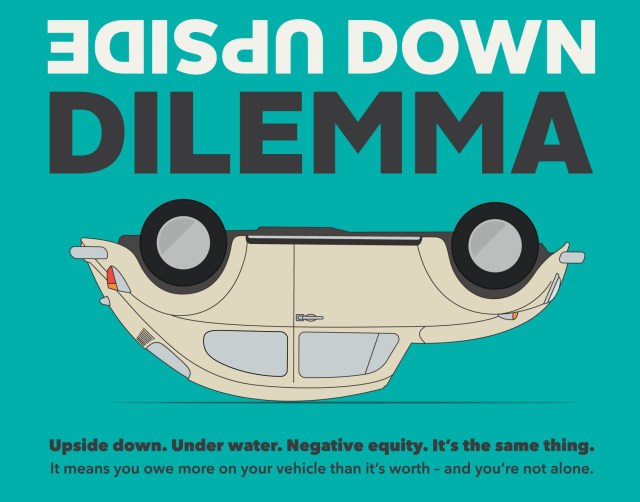Upside down.
It’s a position you usually want to avoid.
Especially if we’re talking about upside down car financing for a vehicle on which you’ll be making monthly payments for some time to come.
Upside down car financing means you owe more money on your vehicle than it’s worth, which can get you in even bigger financial trouble when you want to trade it in for another vehicle. As you’ll see, you can be upside down the moment you leave the dealership’s lot.

Buyers fall into the trap of the upside down (negative equity, under water) dilemma for several avoidable reasons:
- Not doing their research on vehicle costs
- Not shopping for the best loan terms
- Not having enough of a down payment
- Getting unnecessary options
- Stretching out monthly payments
- Rolling over money still owed on their current vehicle into a new, larger loan.
In short, it’s often the result of getting more car than the shopper can afford.
The following shows car shoppers the wrong way and the right way to avoid falling into the large group of people who owe more on their vehicles than those vehicles are worth.
WRONG WAY
- Many people overpay for a vehicle because they didn’t do enough research on costs of purchasing, financing and owning similar makes and models.
RIGHT WAY
- Be diligent with research before you buy a car and understand all the costs of options, financing and taxes so you aren’t already upside down when you drive out the door. Consult resources such as Kelley Blue Book and Consumer Reports to estimate the true value of the car.
WRONG WAY
- Going into a dealership without researching your financing could set you up to overpay on interest.
RIGHT WAY
- See the manufacturer’s website for possible rate deals, as well as online lenders such as Santander Consumer USA’s RoadLoans.com, your local credit unions and banks where you have accounts. Prequalifying also gives you bargaining power with the dealer.
WRONG WAY
- If you don’t put at least 20 percent down, you’re upside down right away. Cars depreciate 20 percent almost immediately and lose 50 percent of value by the third year.
RIGHT WAY
- Make a down payment of at least 20 percent of the car’s total cost, equaling the 20 percent depreciation on the car that happens during the first year of ownership.
WRONG WAY
- Long financing terms are another popular incentive, but if you’re still paying for a car that is five, six or even seven years old, your payments probably won’t keep pace with depreciation.
RIGHT WAY
- Choose the shortest repayment plan you can afford on your monthly budget, because shorter repayment plans mean lower interest rates and faster payoff.
WRONG WAY
- People often choose costly options they don’t need or won’t use, such as a sunroof, leather upholstery, DVD player, etc., creating more debt.
RIGHT WAY
- Ask about incentives. Dealers may offer enough cash incentives to make up the difference for the depreciation hit you will take as soon as you drive away in the vehicle.
WRONG WAY
- Rolling over your financing means you are paying two cars at once – the balance on the old car, plus whatever money you’re financing on the new car. In most cases, that means the total financed already is more than the car is worth and you’re upside down again.
RIGHT WAY
- Pay off your loan before you sell or trade, because you can’t be upside down on a paid-off car. If you know you’ll keep a car for just two or three years, consider leasing instead of buying.
These statements are informational suggestions only and should not be construed as legal, accounting or professional advice, nor are they intended as a substitute for legal or professional guidance.
Santander Consumer USA is not a credit counseling service and makes no representations about the responsible use of or restoration of consumer credit.


